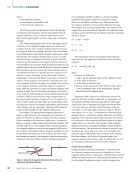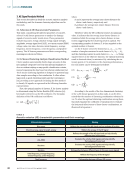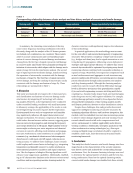structures students can use for real-world
experience.
The Au Sable Lighthouse instrumen-
tation is part of a larger project with
colleague Hannah Blum, an associate
professor of civil and environmental engi-
neering, that involves monitoring historic
structures with support from ERDC-CERL.
“It is truly exciting to see research that
UW-Madison and ERDC-CERL have been
working on for several years culminate
in this first field experiment to innovate
how the government monitors and
manages its historic structures,” says
Dawn Morrison, ERDC-CERL team lead
for the initiative, in a news story about the
collaboration. “We are really grateful to
the National Park Service for supporting
this project and making the Au Sable
Lighthouse available.”
Editor’s note: This 8 January 2025
article, written by Alex Holloway, is
reprinted with permission from the
University of Wisconsin–Madison College
of Engineering website (engineering.wisc.
edu/news).
SENIOR EXECUTIVES
DEPART PHMSA AMID
STRAIN ON PIPELINE
SAFETY AGENCY
Several senior leaders at the Pipeline
and Hazardous Materials Safety
Administration (PHMSA) announced
in mid-March their intentions to leave
the US Department of Transportation
agency or retire within a few months,
including William Schoonover, Associate
Administrator for the Office of Hazardous
Materials Safety. This marks a significant
shift for the agency responsible for over-
seeing US pipeline and hazardous mate-
rials safety.
Bloomberg reported that an exodus
of senior officials, including PHMSA
Executive Director Howard “Mac”
McMillan and the head of the Office
of Pipeline Safety Alan Mayberry, has
intensified challenges for the agency.
The move comes as the Trump admin-
istration’s regulatory rollback and hiring
freeze put additional strain on PHMSA,
which already faces resource and funding
limitations.
The agency, which regulates over
2.7 million miles of oil and gas pipe-
lines, is under pressure with the growing
energy sector, including the rise of CO2
pipelines for carbon capture and storage.
Bill Caram of the Pipeline Safety Trust
expressed concern over the agency’s
ability to handle new challenges with
diminished staffing.
Although PHMSA maintains its
commitment to protecting public safety,
concerns remain about the impact of
staffing shortages, particularly in light
of recent incidents, such as the jet fuel
leak in Pennsylvania’s Upper Makefield
Township, which is under investigation by
the state’s Attorney General.
Congress has increased funding
for PHMSA, but uncertainties remain
regarding the agency’s future and reau-
thorization. Industry experts, including
Rich Felder from the Common Ground
Alliance, warned that budget cuts could
undermine safety efforts.
Senators and representatives from
Pennsylvania have called for stronger
oversight, bearing in mind the recent
pipeline leak, with concerns that reduced
personnel could compromise public
safety and environmental protections.
The departures and downsizing at
PHMSA come at a time of heightened
scrutiny over pipeline safety and regu-
latory effectiveness, with critics warning
that staffing reductions could undermine
the agency’s ability to safeguard public
health and the environment.
NEW DIGITAL SMART
MONITORING
SYSTEM IMPROVES
MAINTENANCE OF
AGING BRIDGES
IN VIETNAM
The Korea Institute of Civil Engineering
and Building Technology (KICT) has
developed a smart monitoring system
utilizing digital sensing technology
to maintain and manage small and
medium-sized aging bridges. This study,
funded by KICT as part of an interna-
tional joint research initiative, also laid the
groundwork for technology diffusion to
ASEAN (Association of Southeast Asian
Nations) countries through collaborative
research with the University of Transport
and Communications (UTC) in Vietnam.
Typically, bridge maintenance moni-
toring technology is applied to large-
scale structures like cable-stayed and
suspension bridges. These systems are
resource-intensive, with complex designs
and installations, limiting their use for
smaller bridges. Current bridge moni-
toring systems are based on analog
measurements and sensing, which are
susceptible to electrical noise and data
quality deterioration. Additionally, analog
sensors require 1:1 wiring between
sensors and receivers, resulting in
increased complexity and installation
costs as the system expands.
To address these limitations, KICT
has adopted digital sensing technology,
which minimizes the risk of data dete-
rioration due to noise and enhances
data transmission speed and processing
capability. Furthermore, by using a
BUS communication serial connection,
multiple sensor data can be integrated
and transmitted through a single wire,
offering a simpler, more cost-effective
solution compared to analog sensors.
In Vietnam, where rapid economic
growth is driving the construction of
transportation infrastructure, including
bridges, there is a growing need for
effective maintenance techniques.
Despite the introduction of overseas
workers and technology, maintenance
efforts have mainly focused on long-
span bridges, with limited applications
for smaller structures due to budget
constraints and a shortage of skilled
professionals. Consequently, there is
an urgent need for efficient monitoring
techniques suited to local conditions.
Under the leadership of Dr. Dong-Woo
Seo at KICT’s Department of Structural
Engineering Research, the team devel-
oped a monitoring system tailored for
small and medium-sized aging bridges
using digital sensing technology. This
system was tested on-site with the UTC
research team in Vietnam, demon-
strating its performance and local
applicability.
Notably, the smart monitoring
system can accurately calculate vertical
SCANNER
|
INDUSTRYNEWS
10
M AT E R I A L S E V A L U AT I O N • M AY 2 0 2 5
experience.
The Au Sable Lighthouse instrumen-
tation is part of a larger project with
colleague Hannah Blum, an associate
professor of civil and environmental engi-
neering, that involves monitoring historic
structures with support from ERDC-CERL.
“It is truly exciting to see research that
UW-Madison and ERDC-CERL have been
working on for several years culminate
in this first field experiment to innovate
how the government monitors and
manages its historic structures,” says
Dawn Morrison, ERDC-CERL team lead
for the initiative, in a news story about the
collaboration. “We are really grateful to
the National Park Service for supporting
this project and making the Au Sable
Lighthouse available.”
Editor’s note: This 8 January 2025
article, written by Alex Holloway, is
reprinted with permission from the
University of Wisconsin–Madison College
of Engineering website (engineering.wisc.
edu/news).
SENIOR EXECUTIVES
DEPART PHMSA AMID
STRAIN ON PIPELINE
SAFETY AGENCY
Several senior leaders at the Pipeline
and Hazardous Materials Safety
Administration (PHMSA) announced
in mid-March their intentions to leave
the US Department of Transportation
agency or retire within a few months,
including William Schoonover, Associate
Administrator for the Office of Hazardous
Materials Safety. This marks a significant
shift for the agency responsible for over-
seeing US pipeline and hazardous mate-
rials safety.
Bloomberg reported that an exodus
of senior officials, including PHMSA
Executive Director Howard “Mac”
McMillan and the head of the Office
of Pipeline Safety Alan Mayberry, has
intensified challenges for the agency.
The move comes as the Trump admin-
istration’s regulatory rollback and hiring
freeze put additional strain on PHMSA,
which already faces resource and funding
limitations.
The agency, which regulates over
2.7 million miles of oil and gas pipe-
lines, is under pressure with the growing
energy sector, including the rise of CO2
pipelines for carbon capture and storage.
Bill Caram of the Pipeline Safety Trust
expressed concern over the agency’s
ability to handle new challenges with
diminished staffing.
Although PHMSA maintains its
commitment to protecting public safety,
concerns remain about the impact of
staffing shortages, particularly in light
of recent incidents, such as the jet fuel
leak in Pennsylvania’s Upper Makefield
Township, which is under investigation by
the state’s Attorney General.
Congress has increased funding
for PHMSA, but uncertainties remain
regarding the agency’s future and reau-
thorization. Industry experts, including
Rich Felder from the Common Ground
Alliance, warned that budget cuts could
undermine safety efforts.
Senators and representatives from
Pennsylvania have called for stronger
oversight, bearing in mind the recent
pipeline leak, with concerns that reduced
personnel could compromise public
safety and environmental protections.
The departures and downsizing at
PHMSA come at a time of heightened
scrutiny over pipeline safety and regu-
latory effectiveness, with critics warning
that staffing reductions could undermine
the agency’s ability to safeguard public
health and the environment.
NEW DIGITAL SMART
MONITORING
SYSTEM IMPROVES
MAINTENANCE OF
AGING BRIDGES
IN VIETNAM
The Korea Institute of Civil Engineering
and Building Technology (KICT) has
developed a smart monitoring system
utilizing digital sensing technology
to maintain and manage small and
medium-sized aging bridges. This study,
funded by KICT as part of an interna-
tional joint research initiative, also laid the
groundwork for technology diffusion to
ASEAN (Association of Southeast Asian
Nations) countries through collaborative
research with the University of Transport
and Communications (UTC) in Vietnam.
Typically, bridge maintenance moni-
toring technology is applied to large-
scale structures like cable-stayed and
suspension bridges. These systems are
resource-intensive, with complex designs
and installations, limiting their use for
smaller bridges. Current bridge moni-
toring systems are based on analog
measurements and sensing, which are
susceptible to electrical noise and data
quality deterioration. Additionally, analog
sensors require 1:1 wiring between
sensors and receivers, resulting in
increased complexity and installation
costs as the system expands.
To address these limitations, KICT
has adopted digital sensing technology,
which minimizes the risk of data dete-
rioration due to noise and enhances
data transmission speed and processing
capability. Furthermore, by using a
BUS communication serial connection,
multiple sensor data can be integrated
and transmitted through a single wire,
offering a simpler, more cost-effective
solution compared to analog sensors.
In Vietnam, where rapid economic
growth is driving the construction of
transportation infrastructure, including
bridges, there is a growing need for
effective maintenance techniques.
Despite the introduction of overseas
workers and technology, maintenance
efforts have mainly focused on long-
span bridges, with limited applications
for smaller structures due to budget
constraints and a shortage of skilled
professionals. Consequently, there is
an urgent need for efficient monitoring
techniques suited to local conditions.
Under the leadership of Dr. Dong-Woo
Seo at KICT’s Department of Structural
Engineering Research, the team devel-
oped a monitoring system tailored for
small and medium-sized aging bridges
using digital sensing technology. This
system was tested on-site with the UTC
research team in Vietnam, demon-
strating its performance and local
applicability.
Notably, the smart monitoring
system can accurately calculate vertical
SCANNER
|
INDUSTRYNEWS
10
M AT E R I A L S E V A L U AT I O N • M AY 2 0 2 5













































































